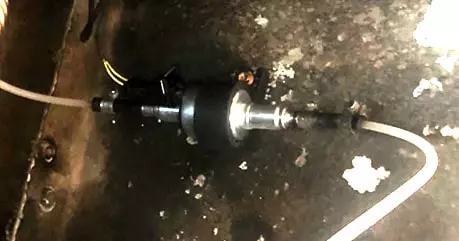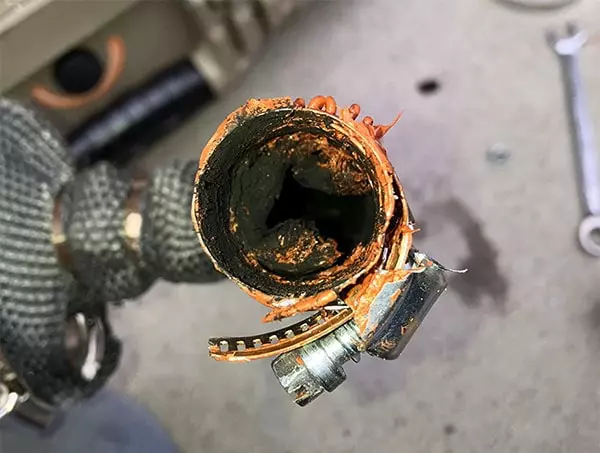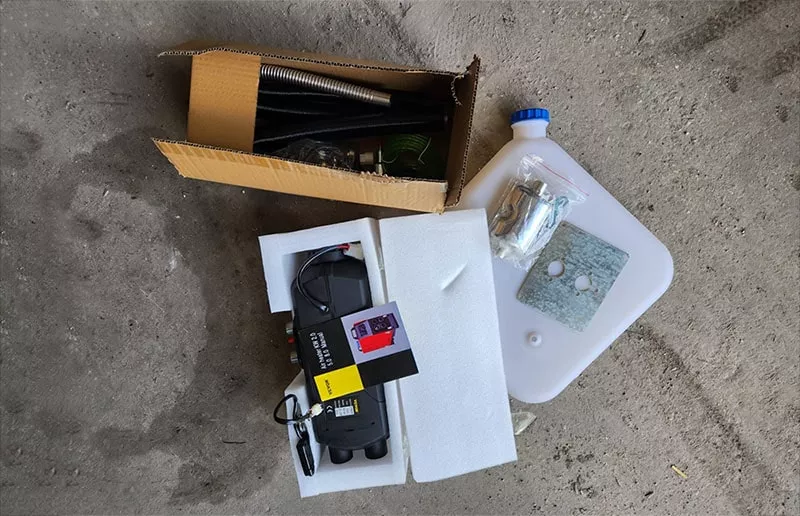The single major disadvantage of diesel heaters is, in my opinion, that they contain too many different parts:
When your diesel heater is not getting hot / not blowing hot air, the issue can be practically anywhere. It can be the fuel pump, electronic controls, the car battery, the atomizer, the combustion chamber, anything.
This makes them relatively hard to troubleshoot. However, it’s not as hard as you think. When diesel heaters stop working, it’s usually just a bunch of common problems you need to check.
In this guide, we’ll have a look at these most common problems that cause your diesel heater to not blow hot air. And, of course, we’ll also check out how to fix each problem.
So, let’s start.
How to Fix a Diesel Heater Not Getting Hot
1. Fuel Pump Setting Too Low
When the fuel pump is not pumping fuel quickly enough or with insufficient force, your diesel heater can’t heat properly.
How to check it: Ensure the fuel pump’s pumping frequency or pressure is not too low.
How to fix it: Increase the fuel pump setting to allow more fuel to reach your diesel heater. Note that this setting may not be available on all diesel heaters.
If you can’t adjust the fuel pump setting on your diesel heater, inspect the fuel pump manually and verify that it works correctly.
 Ensure the fuel pump is working and pumping properly.
Ensure the fuel pump is working and pumping properly.
2. Low Battery
A depleted battery, even if it’s just slightly below 12 Volts, can’t properly power a diesel heater. Oftentimes, it causes the glow plug to not get hot enough, or the fuel pump to not run with enough power.
How to check it: Use a multimeter to ensure the battery is fully charged. I’d suggest storing a digital multimeter in your car to check the battery status every now and then. This way, you’ll know exactly when to recharge your battery.
How to fix it: Recharge your battery. In the meantime, try operating the heater while your car, van, or truck engine is running to provide sufficient power. When the engine is running, you should get a solid 12 Volts. This obviously only works if your diesel heater is directly connected to the car battery and not an external battery.
3. Bad Fuel Line Setup
Diesel heater installation can be annoying. Especially if your vehicle was not laid out for an additional heater. So, oftentimes you end up with an improvised setup tailored to your car, van, or truck.
But in any case, you should make sure that the fuel line is cleanly set up. A too-long fuel line with dents and kinks can impede the flow of diesel to the heater and prevent it from heating.
How to check it: Check how the fuel line is set up. Look out for dents, kins, and unnecessary length.
How to fix it: Some diesel heaters come with multiple fuel lines - try using a different one. Ensure the pipe is as short as possible without dents or kinks, and that it doesn’t contain air bubbles. Surprisingly, thinner pipes can be more effective than larger ones, as they require less power to build pressure.
 Try different fuel lines. Usually, diesel heaters come with a set of them. Test which one works best for you.
Try different fuel lines. Usually, diesel heaters come with a set of them. Test which one works best for you.
4. Clogged or Loose Atomizer Screen
Since diesel does not combust easily, it needs to be atomized before ignition. That’s what the atomizer does.
But if the atomizer screen is clogged or improperly seated, it can significantly reduce the efficiency of your diesel heater, or cause it to stop working & not get hot at all.
How to check it: Disassemble the diesel heater and inspect the atomizer screen for soot, dirt, or clogging.
How to fix it: Regular cleaning is necessary for the atomizer screen to function properly.
Clean the screen (I recommend using Brakleen brake cleaner) or replace it if necessary, ensuring it is firmly seated.
A loosely seated atomizer screen will allow some un-atomized diesel to reach the glow plug, which should never happen.
5. Clogged Fuel Line
This one is rather obvious, but happens more often than you might think.
Diesel fuel lines can clog after long periods of inactivity, which prevents diesel from reaching the heater.
How to check it: Inspect the diesel fuel line, starting from the tank until it connects to the heater. Also, check the pump and, if necessary, disassemble your diesel heater for a complete inspection, tracing where the diesel goes.
You can test the fuel line by unmounting it and blowing through it.
How to fix it:: Unclog the fuel line, using compressed air, or, if necessary, with a long, thin nylon brush. There are fuel line cleaning sets specially made for this. Once the fuel line is free, re-prime the pump.
6. High Altitude Mode
The higher the altitude, the lower the oxygen content in the air. If you run a diesel heater at high altitudes, it can lead to improper combustion and increased soot buildup.
Some diesel heaters have a high altitude mode setting to adapt oxygen intake. Since it changes combustion settings, this mode should only be activated at high altitudes, which it is designed for.
How to check it: Check the altitude of your current location. At high altitudes (>8,000 feet), heaters may burn improperly, leading to increased soot buildup, and lower efficiencies.
How to fix it: If you are at a high altitude, you need to activate high altitude mode. At low altitudes, disable it.
For instance, on Happy Buy 5kW Diesel heater models, press and hold the OK and settings buttons together to switch from regular to high altitude mode. For other models, consult the manual.
Some other models, such as some Vevor diesel heaters, have an automatic altitude adaption mechanism, so you don’t have to manually switch modes.
If your diesel heater doesn’t have an altitude setting, you can still manually adjust the oxygen intake of your heater.
7. Electrical Connection Issues
Your diesel heater might not be working properly if the wiring is faulty. Luckily, this is straightforward to check.
How to check it: Inspect all electrical connections for corrosion or looseness. If all exterior connections are fine, disassemble your diesel heater and inspect the internal circuitry for faults. I like to set a timer to 5 minutes and just stare at the electronics. In most cases, you’re able to spot faults visually.
You can also wiggle the wires with your fingers to check that they are securely connected.
How to fix it: Clean any dirty or corroded connections with a contact cleaner and ensure they are securely fastened.
If you find any other electronic flaws (such as burn marks or blown parts), try to identify the model number (or at least the electric specification) of the affected part and replace it. This requires soldering skills.
8. Malfunctioning Thermostat
The thermostat controls the burn rate of the fuel to reach a set temperature. To do that, thermostats must constantly measure the temperature of your diesel heater.
A malfunctioning thermostat can fail to regulate the heater’s temperature, leading to heating issues.
How to check it: Test the thermostat’s functionality with a multimeter. Locate the temperature sensor wired to the thermostat and check if it reads a voltage. Monitor the sensor voltage and confirm that it increases with increasing temperature.
How to fix it: If your thermostat’s temperature sensor is faulty, replace it. Also, check for blown parts or parts with burn marks on the circuitry and replace any faulty parts you locate.
9. Air in the Fuel System
Air bubbles in the fuel system can disrupt the steady flow of diesel, impacting the heater’s functionality.
How to check it: Open up your diesel heater and look for air bubbles in the transparent parts of the fuel line.
How to fix it: Bleed the fuel system to remove any air pockets. Then, prime the pump and try running your diesel heater again.
If bubbles build up again, likely there is an issue with the fuel line itself. Either it has tiny air cracks that allow air to enter the system, or it is improperly installed.
Install a new fuel line. Keep it as short as possible and avoid dents and kinks.
10. Worn-out Glow Plug
A worn-out glow plug can hinder the ignition process in your diesel heater, leading to starting issues or inefficient heating.
How to check it: Disassemble your diesel heater and remove the glow plug. Visually inspect it. Look for physical damage, such as cracks or swelling, and signs of overheating like blistering or excessive carbon buildup.
You can use a car battery to test a glow plug. Connect the positive terminal of the battery to the glow plug’s electrical connector and ground the body of the plug. Power the plug and check if the tip glows red-hot quickly (it should take no longer than 1-2 seconds).
How to fix it: Replace the glow plug if it shows signs of wear or fails the electrical test. Ensure the replacement is compatible with your heater’s specifications. After replacing it, test the heater to ensure it starts properly.
11. Blocked Exhaust or Air Intake
A clear path for exhaust and air intake is crucial for the optimal functioning of your diesel heater. Blockages in these areas can lead to inefficient operation or even prevent the heater from working.
How to check it: Carefully examine both the exhaust and air intake vents. Look for any obvious blockages, such as leaves, dirt, or debris, that might impede airflow.
Use a flashlight to inspect deeper sections.
How to fix it: Remove any visible blockages by hand or with tools. For more stubborn debris, compressed air can be effective.
 Broken heaters, especially when they leak fuel, or have a similar fatal issue, clog up quickly. If your diesel heater is as clogged as the one in the image above, get a new one.
Broken heaters, especially when they leak fuel, or have a similar fatal issue, clog up quickly. If your diesel heater is as clogged as the one in the image above, get a new one.
12. Overheating Due to Poor Ventilation
Since diesel heaters blow hot air, they have to first suck in cold air. The air entering, however, contains dust dust particles, which clog the heater over time. This can cause overheating.
Also, a too-narrow placement, for example under a car seat, worsens the diesel heater’s chances of overheating.
How to check it: Turn on your diesel heater. If it starts heating, but then shuts off on its own, it is likely an overheating issue.
Check if the heater is placed near materials or in a position that might restrict airflow, such as tightly enclosed spaces or near furniture and fabrics.
How to fix it: Disassemble your diesel heater and thoroughly clean its internals. Remove any dust that can block airflow and cause overheating.
Reposition the heater or clear out surrounding items to improve air circulation.
Try running your diesel heater on lower heat settings and see if it works.
What to do if you still can’t fix your Diesel Heater
Get a new Diesel Heater
If you’ve tried all these fixes and your diesel heater still isn’t functioning properly, it might be time to consider purchasing a new one.
My recommendation is this LF Bros diesel heater, which is compatible with 12V, 24V, and 110V power sources. So, you can even run it at home, or in a garage, off your wall outlet.
With 5kW it is more than hot enough to keep large spaces well-heated, but it’s not too large to fit in your car, van, or truck.
A (Better) Alternative: Propane Heaters
I’ve described all the differences between diesel heaters and propane heaters in a thorough post already. Here’s the gist of it:
Diesel heaters have one fundamental drawback. Since diesel burns so poorly, diesel heaters need several helping mechanisms. They need atomizers, glow plugs, air intakes, exhausts, electric controls, built-in blowers, etc.
Because of that, all diesel heaters require electricity to run. And because diesel heaters are such complex devices, they are complex to troubleshoot (as you’ve seen in this article).
 Diesel heaters consist of dozens of components. All of which can break. Which makes them hard to troubleshoot.
Diesel heaters consist of dozens of components. All of which can break. Which makes them hard to troubleshoot.
Propane heaters, on the other hand, are much easier to operate. They don’t require electricity. And they contain no moving parts that wear down over time. So, they practically last a lifetime.
If you can’t fix your diesel heater, my personal recommendation is to seriously consider getting a propane heater. They are headache-free heaters.
My starter recommendation is the Mr. Heater Big Buddy (click to view it on amazon). If you want to know more about it before buying, check out this propane heater guide.
Conclusion
Usually, you can fix a diesel heater not getting hot by ensuring the fuel line is unclogged, the battery is charged, and the device is clean and free of dust.
If these 3 central fixes don’t work in your case, you need to inspect the electronics, the glow plug, and the fuel pump.
If you can’t fix your diesel heater not working / not getting hot / not blowing hot air, I highly recommend getting a new heater. They don’t cost too much. And, if you’re done with diesel heaters, try a propane heater next time. Propane heaters are much simpler and less error-prone than diesel heaters.
